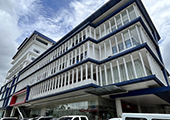
-
МјРЇСІИёСЖШИМі
-
 Malacañang Palace-Official Residence of the Pres
Malacañang Palace-Official Residence of the Pres 139,194
139,194 -
 Amana Water Park
Amana Water Park 115,825
115,825 -
 IFUGAO TRIBE
IFUGAO TRIBE 109,858
109,858 -
 Santacruzan-The Queen of all Filipino Festivals109,669
Santacruzan-The Queen of all Filipino Festivals109,669 -
 Water Refilling Station: an alternative source of drink107,952
Water Refilling Station: an alternative source of drink107,952 -
 LAMBANOG-THE POOR MAN\'S DRINK105,072
LAMBANOG-THE POOR MAN\'S DRINK105,072 -
 Christmas Parol [lantern in English]104,763
Christmas Parol [lantern in English]104,763 -
 HANGING RICE97,475
HANGING RICE97,475 -
 Taoist Temple94,339
Taoist Temple94,339 -
 Corn Fields in the Philippines90,840
Corn Fields in the Philippines90,840

Why is La Trinidad Valley called the salad bowl of the Philippines?
At 5,000 feet altitude yet in the tropics, this fertile, flat volcanic valley of 5 miles diameter yields fresh
fruits and vegetables every day of the year! Not only this, just the sight of the area is unbelievable
after driving through the high, steep mountains is quite miraculous! Now, go see it!




Top row: broccoli and red beets
Bottom: cherry tomatoes and bell peppers Look at all that lettuce!


curly leaf parsley


Benguet is known as the vegetable basket of Luzon. Temperate vegetables like cauliflower, lettuce,
carrot, asparagus, broccoli, cucumber, beans, peas, cabbage, etc. are grown in the vegetable farms
of Buguias and other highland towns.
These produce are brought to the trading post in bulk packaging (sacks, crates) where wholesalers
await them for distribution and marketing in Baguio City, other parts of the province and as far as
Metro Manila.


Large-scale vegetable farming became evident during the 1960ЁЏs. La Trinidad became one of the leading
vegetable-producing municipalities in the entire country. This earned for its distinction as ЁА The Salad Bowl
of the PhilippinesЁБ in the 1980ЁЏs. Toward the end of the decade, farmers began to shift from vegetable
production to strawberry and cutflower production. To this day, La Trinidad is recognized as ЁАThe Strawberry
Fields of the PhilippinesЁБ. In 1998, the barangay of Bahong was declared ЁБthe Rose Capital of the PhilippinesЁБ.
Aside from these distinctions, La Trinidad is also known as a tradersЁЏ marketing center if not for the
province but also in the Cordilleras. La Trinidad remains to be an agricultural area with urbanization
fast creeping in the valley area.

- ЁЄ

- ЁЄ
- ЁЄSalapan Festival
- ЁЄEmpanada Festival (Batac City)
- ЁЄPADUL-ONG FESTIVAL
- ЁЄKaumahan Festival in Barili
- ЁЄKAGASANGAN FESTIVAL
- ЁЄLalin Festival in Asturias
- ЁЄTinabuay Festival
- ЁЄGayon Bicol Festival
- ЁЄPINYASAN FESTIVAL in CAMARINES
- ЁЄMAGAYON FESTIVAL
- ЁЄBANAUAN FESTIVAL (BARANGAY.GUA
- ЁЄThe Tuna Festival in Gensan
- ЁЄPINTOS FESTIVAL BOGO CITY, CEB



- ЁЄ

- ЁЄ
- ЁЄ
- ЁЄCEBU WESTOWN LAGOON
- ЁЄGREEN LAGOON, COMPOSTELA
- ЁЄCALLAO CAVE
- ЁЄMOUNT PINATUBO IN PHILIPPINES
- ЁЄBATAN ISLAND in Batanes.
- ЁЄCALAGUAS ISLAND, CAMARINES NOR
- ЁЄAGHO ISLAND
- ЁЄCARAMOAN ISLAND IN CAMARINES S
- ЁЄSAMBAWAN ISLAND
- ЁЄPLACES TO VISIT IN LANAO DEL N
- ЁЄPLACES TO VISIT IN ZAMBOANGA C
- ЁЄPlaces to visit in Rizal Provi












 ЧЪРкДхФФ ОпАЃЛѓДу ПРЧТ
ЧЪРкДхФФ ОпАЃЛѓДу ПРЧТ 12ГтПЌМг МвКёРкИИСЗ 1РЇ
12ГтПЌМг МвКёРкИИСЗ 1РЇ
 ГЛАд ИТДТ ОюЧаПј УЃБт
ГЛАд ИТДТ ОюЧаПј УЃБт
 ИЎОѓ ЧаБГ ЙцЙЎБт
ИЎОѓ ЧаБГ ЙцЙЎБт
 СжИЛПЁ ГЛАЁ ОЕ КёПыРК?
СжИЛПЁ ГЛАЁ ОЕ КёПыРК? УжАэАЁМККё РЬКЅЦЎ СёБтБт
УжАэАЁМККё РЬКЅЦЎ СёБтБт
 ЧіСіПЁМЕЕ ЧЪРкДхФФ!
ЧіСіПЁМЕЕ ЧЪРкДхФФ! ЧіСіПЁМ АЁДЩЧб
ЧіСіПЁМ АЁДЩЧб









 ЧЪРк ЦЏБо Ч§ХУ! ФСНУОюСі МКёНК
ЧЪРк ЦЏБо Ч§ХУ! ФСНУОюСі МКёНК

































